Massachusetts Museum of Contemporary Art
North Adams, Berkshires

MASS MoCA Campus Development Phase III
Expansion Background Details And Artists
Bruner/Cott and Associates, Architects
The programs and architectural renovations announced today (November 17, 2014) constitute the third phase of MASS MoCA’s multi-decade redevelopment of its 600,000 SF, 24-building historic mill complex.
“The gradual re-inhabitation of this noble complex of mill buildings has been an organic process, interweaving art from afar with homegrown projects, layering galleries, stages, and art fabrication facilities into the existing physical fabric in ways that preserve the site’s very special sense of place, while also being useful, direct, and practical,” notes MASS MoCA’s Founding Director, Joseph Thompson. “Even this Phase III project is unfolding in steps. The first major project within the Phase III scope is fully complete, and opened to the public this past summer season: In collaboration with MASS MoCA, the Hall Art Foundation repurposed an abandoned one million gallon concrete water tank to create a seasonal 10,000 square foot gallery to house three monumental installations by Anselm Kiefer. The Hall Art Foundation also contributed many improvements to our West Main Street access road and plaza, which, upon completion of the rest of our Phase III improvements, will provide an alternative public entry to the museum from the downtown business district for pedestrians and bicyclists. Like the Kiefer installation, much — but not all — of the remaining Phase III development will be similarly slated for long-term installations of milestone art by pivotal artists of today and the recent past, complementing our roster of temporary changing exhibitions and our year-round schedule of performing arts events and music festivals. On that topic, I would emphasize two points: First, with today’s announcement, I would like to highlight that we are not giving up one square inch of galleries devoted to our program of temporary exhibitions and performing arts events. On the contrary, we are in fact adding dramatic new spaces to support changing exhibitions of experimental art by young, emerging, and mid-career artists working across all media. Secondly, this is a very long-term investment in institutional capacity. Even with all the new programs and partners announced today, we will still have ample room to grow into this Phase III footprint — and beyond — and we will continue to seek out exciting projects and interesting programming partners in the coming months and years ahead. We are not nearly done.”
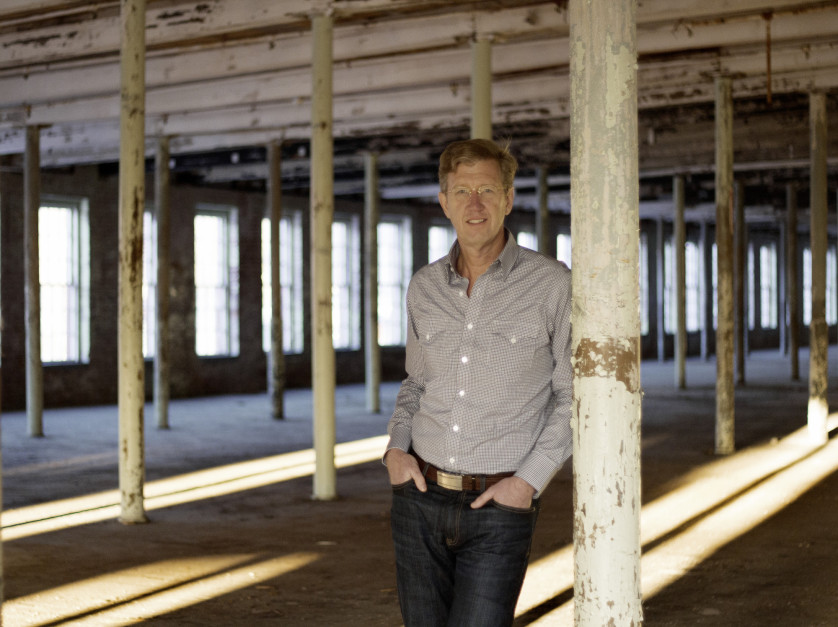
MASS MoCA Founding Director Joseph Thompson in the museum’s Building 6, slated for development beginning spring 2014. Date 06 March 14. Credit Olympia Shannon.
———————————————————————————

Building 6. Date 22 September 14. Credit Aoife Morris.
Building 6: MASS MoCA’s spatially generous, raw, industry-imbued architecture, and, in particular, Building 6’s specific characteristics, which include high floor loading (in the case of Bourgeois) and horizontally extensive controlled-light spaces at the center of the building (in the cases of Turrell, Holzer, Rauschenberg, and Anderson), together with a dramatic, unusually shaped building perimeter penetrated over 300 mullioned windows which yield natural side light and views out onto the surrounding Berkshire hills, residential neighborhoods, and MASS MoCA’s network of interlocking courtyards and elevated walkways (for circulation, temporary program spaces, and special installations).
———————————————————————————
MASS MoCA has found success leveraging its generous, well-lit industrial spaces, its growing audiences, and its sophisticated technical capacities to collaborate with artists, collectors, foundations, and educational institutions, bringing to the public important and coherently exhibited bodies of art that might be otherwise unseen.
MASS MoCA programming and the physical space are currently developed in three distinct ways:
- exhibitions, performing arts programs, and spaces that are developed and presented solely by MASS MoCA’s internal team of curators and producers, including nearly all of the museum’s roster of temporary exhibitions and non-festival performing arts events;
- exhibitions and performing arts programs that MASS MoCA co-curates or produces in close collaboration with other institutions, artists, or producers, such as its FreshGrass and Bang on a Can Festivals, its co-presentations with Jacob’s Pillow realized with the Irene Hunter Fund for Dance, and its Sol LeWitt Retrospective, co-organized with Yale and the Williams College Museum of Art;
- long-term installations for which MASS MoCA provides space, technical support, and infrastructure to other curatorial voices, institutions, and programmers, such as the Hall Art Foundation’s presentation of Anselm Kiefer, and Wilco’s Solid Sound Festival. In all three variations of its programming model, MASS MoCA does not own art, but rather provides space, time, expertise, and access to its growing audience to those who wish to loan art or otherwise provide programming and financial resources in order to bring art and culture to a wider audience. “Concentrating and clustering programs and collections, sharing museum services and spaces, and efficiently recycling existing buildings turn out to be alluring, both programmatically and economically,” notes museum Director Joseph Thompson. “Ours is not a monolithic model, but neither is the world in which we live today. Our audience is sophisticated and enjoys seeing and hearing multiple points of view, all conveniently clustered within this singular factory-campus environment. As just one index of that, our annual attendance has grown slowly but surely almost every year since opening, from 40,000 to 80,000 per year in the early years, to 120,000 to 130,000 following the opening of the LeWitt galleries in 2008, to over 160,000 last year in the wake of three very successful music festivals that we co-curate with others, the Kiefer opening, and unusually strong gallery attendance.” Expanding on the “campus of museums” model pioneered through its Sol LeWitt Wall Drawing Retrospective, in which the museum teamed up in 2008 with the Yale University Art Gallery and the Williams College Museum of Art, the museum recently worked with the Hall Art Foundation to realize a massive, three-part sculpture and painting installation by the German artist, Anselm Kiefer. The museum partners frequently with Jacob’s Pillow Dance, the Grammy-winning rock band Wilco, Bang on a Can, and the Clark Art Institute, among others, to produce a year-round calendar of festivals, exhibitions, performances, and educational programs.
“For our artists and institutional partners, co-locating at MASS MoCA provides access to a lively and decidedly younger audience interested in new art and new ideas,” added Deputy Director Larry Smallwood. “We are able to offer compelling economics and solid logistical, technical, and visitor services support to our partners. The galleries are spacious. The nearby scholarly resources of Williams College, the Clark, Massachusetts College of Liberal Arts, and Bennington College are formidable. It’s a good neighborhood for art.”
Thompson continued, “For our public, having quasi-permanent exhibitions displayed cheek-by-jowl with MASS MoCA’s vibrant roster of changing exhibitions and performances provides many reasons to return. There is something exciting about having these ‘proton-like’ installations of art by highly recognized artists at our core, around which our changing shows, often of younger artists or of established artists trying something utterly new, can orbit like electrons, each amplifying and informing the other. The changing shows we organize internally trigger reasons for repeat visitation. The long-term installations provide a continuity of experience, artworks of great meaning that people can enjoy over and over again throughout their lives.”
“And for our staff and institution, long-term, high-quality art installations provide continuity, depth, financial stability, and a welcome counterpoint to the fast pace of our changing exhibitions and performance schedule,“ added Smallwood. “And finally, for our home region, adding more destination quality collections attracts more visitors and extends the length of their stay.”
In selecting the initial group of long-term program collaborators, MASS MoCA programming staff sought to:
- Spotlight and amplify the cross-disciplinary approach that is deeply embedded within MASS MoCA’s mission and curatorial orientation. MASS MoCA has a robust history of presenting innovative music, dance, and performing arts programming, all year-round, in addition to visual arts exhibitions. Indeed, a full fifty percent of the institution’s human, financial, and programmatic bandwidth is expended on performing arts, film, theater, dance, spoken word, and video: the institution is therefore particularly drawn to artists whose work spans the fields of music, dance, performance art, theater, literature, and visual arts (as in the case of Rauschenberg, Anderson, Holzer, and Schonbeck).
- Feature artists whose working methods and materials exploit MASS MoCA’s spatially generous, raw, industry-imbued architecture, and, in particular, Building 6’s specific characteristics, which include high floor loading (in the case of Bourgeois) and horizontally extensive controlled-light spaces at the center of the building (in the cases of Turrell, Holzer, Rauschenberg, and Anderson), together with a dramatic, unusually shaped building perimeter penetrated over 300 mullioned windows which yield natural side light and views out onto the surrounding Berkshire hills, residential neighborhoods, and MASS MoCA’s network of interlocking courtyards and elevated walkways (for circulation, temporary program spaces, and special installations).
- Ground and localize our patrons’ experience of being within our historic factory-campus (as opposed to being within a collection of abstract, white box gallery spaces, which could be anywhere), meshing installations with masonry facades and post & beam interior structure, always conscious of the community of artists and community of regional patrons who distinguish MASS MoCA: Natalie Jeremijenko’s Tree Logic exists only at MASS MoCA, for example, creating a signature gesture at the museum’s front door. A symbol of the unexpected, Tree Logic’s most sophisticated and knowing viewers are local residents and repeat visitors who have observed the sculpture’s unique botanical growth cycles over many years.Through repeated residencies, Michael Oatman, who teaches at nearby Rensselaer Polytechnic Institute, has created a series of powerful site-specific works deeply rooted in the manufacturing and scientific legacy of this site, including his all utopias fell, created over three years of intense research and fabrication in collaboration with artists who live in or near North Adams, including stained glass artist Debora Coombs.
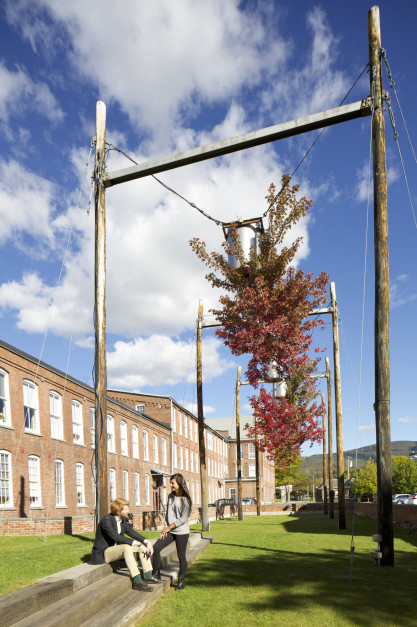
Courtyard, upside-down trees, iconic clocktower, museum entrance, Tree Logic, Natalie Jeremijenko. Date 28 September 13. Credit Zoran Orlić.
A series of sound installations by Christina Kubisch, Bruce Odland, Sam Auinger, Walter Fähndrich, and Glenn Kotche have resulted in a powerful collection of acoustic interventions and sound sculpture both on and off our campus, requiring exploration and discovery not only of MASS MoCA’s 16-acre campus and its manufacturing history, but also of North Adams’ downtown and nearby parks.
Michael Glier’s Travel Light, a MASS MoCA commission, is visible through the museum gallery windows, though it resides as a permanent installation and neighboring gathering spot on the property of the Porches Inn.
For his massive sound installation which occupies the industrial relic of the site’s former Boiler House, All Those Vanished Engines, Stephen Vitiello commissioned local author and Williams College faculty member Paul Park, who provided the story line and text, and local businessman John Sprague (former C.E.O. of Sprague Electric Company, which was the former occupant of the MASS MoCA complex), who provided voice-over narration.
Sol LeWitt designed his installation using the post-and-beam grid structure of Building 7 as his starting point, a sort of 3D graph paper on which he configured his exhibition. Similarly, Anselm Kiefer and his design collaborator, Bill Katz, took a one million gallon abandoned concrete water tank as the basis of their installation design for the Hall Art Foundation’s collection of Kiefer works.

Anselm Kiefer, Velimir Chlebnikov, 2004 (detail), 30 paintings: oil, emulsion, acrylic, lead and mixed media on canvas. 18 paintings: 75 x 130 inches (190.5 x 330 cm) each. 12 paintings: 75 x 110 inches (190.5 x 280 cm) each. Hall Collection. Photo: Arthur Evans. Courtesy Hall Art Foundation. © Anselm Kiefer.
In short, there is a particularity to these and other works — a specific relationship to place, to the structural qualities of specific buildings, to our region and its history, and to artists who are also neighbors – which will be extended in the new round of Phase III long-term installations.
From MASS MoCA’s earliest work with artists such as Mario Merz, Robert Wilson, David Byrne, Tim Hawkinson, Laurie Anderson, Bill T. Jones, Robert Rauschenberg, Merce Cunningham, Robert LePage, and Bang on a Can, to more recent work with Ann Hamilton, Cai Guo-Qiang, Wilco, Cynthia Hopkins, Iñigo Manglano-Ovalle, Carsten Höller, Xu Bing, David Dorfman, Nick Zammuto, Simon Starling, and Katharina Grosse (to name just a few of the over 3,000 artists and groups hosted at MASS MoCA), its visual and performing arts curators have been drawn to artists whose work has a dramatic, theatrical approach to space, but also to artistic practices that ignore the lines that often separate the fields of performing, literary, and visual arts. MASS MoCA curators seek out complex confluences: of art, language, sound, space, film, video, dance, music, theater. Perhaps owing to the history of manufacturing, labor, and scientific and commercial R&D for which the first two tenants of this site were known, MASS MoCA staff is always interested in helping artists make new things, especially things that might be difficult or impossible to achieve in time- and space-constrained urban settings. We also like to keep the processes and techniques of art-making as transparent as is logistically and aesthetically possible because our audience likes to see art being made.
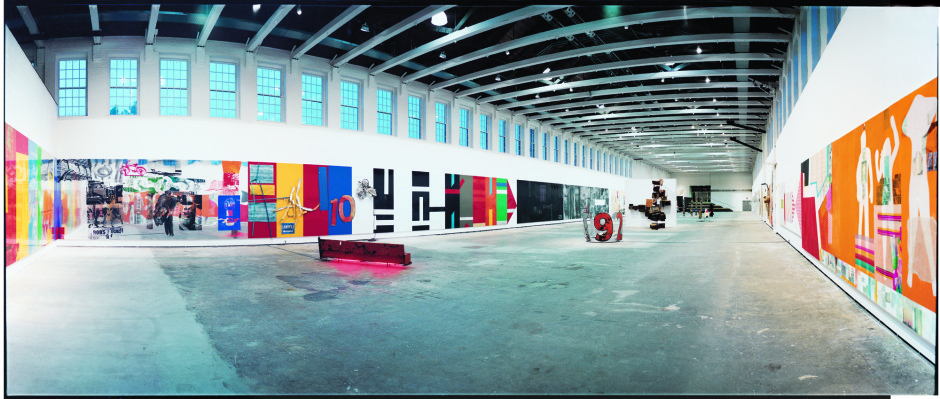
Robert Rauschenberg (B. 1925, Port Arthur, Texas). The 1/4 Mile or 2 Furlong Piece. On display in Building #5 from May 1999 to April 2000.
For MASS MoCA’s curatorial team, Robert Rauschenberg’s emphasis on chance operations, his career-long engagement with the performing arts, and perhaps most especially his deeply held belief that art can make a real and positive difference in the world — an idea that is at the very core of MASS MoCA’s dual-head cultural and economic development mission — make working with the Rauschenberg Foundation a natural fit for MASS MoCA. Our partnership with the Rauschenberg Foundation will center on changing exhibitions of new work by both emerging and established artists, realized, in part, in conjunction with its existing Captiva residency program. Those changing shows will be interspersed from time to time with tightly focused temporary exhibitions of Rauschenberg’s own art. In addition, there will be several longer-term installations on view, on a slowly revolving basis. Some of these changing exhibitions will be organized with scholars and students from nearby educational institutions, including, of course, the excellent Williams College-Clark Art Institute Graduate Program in the History of Art, which has been a long-term curatorial, scholarly and internship resource for MASS MoCA and its partners.
Our collaboration with Louise Bourgeois’ Easton Foundation will exploit MASS MoCA’s rugged load-bearing floors (and the opportunity to add yet more capacity during construction) and the exquisite side lighting which distinguishes Building 6. The density, gravity, and material presence of this concentrated suite of stone sculpture — together with the strikingly detailed and allegorically rich references to the human body for which her work is well known — will form a poetic counterpoint to James Turrell’s immersive, magisterially proportioned light and space environments, in which one’s sense of weight, mass, orientation, and bodily presence almost evaporates before the spiritual qualities of pure light. If MASS MoCA is not a place for cookie-cutter exhibitions of framed easel paintings exhibited on the white walls of perfectly proportioned galleries, it can handle works requiring large volumes of space quite well, and complex rigging projects speak to the millwright legacy of our factory buildings. Vast volumes of space articulated in light by Turrell, together with works of powerful mass and density carved by Bourgeois are right up our alley.
Laurie Anderson was one of the first artists-in-residence at MASS MoCA, returning on multiple occasions to develop her unique practice of music, video design, theater and storytelling. Having enjoyed her work repeatedly in “work-in-progress” showings over the past 15 years, MASS MoCA’s local audience may now rank as among the most knowledgeable and sophisticated Anderson fans anywhere in the world. MASS MoCA staff looks forward to formalizing our relationship as Anderson’s studio home away from home. The production- oriented “live studio” aspect of her vision for her space in North Adams — and the fact that her working studio and archives will be open to the MASS MoCA public, makes her a natural fit. As MASS MoCA’s visitors have come to know and love, the process of art-making is often presented in ways that are remarkably transparent in our galleries and on our stages. Anderson’s production studio and “living archive” will simultaneously function as a metaphorical entryway to a series of audio/video galleries in which her recorded performances will be on long-term exhibition, in rotation, and perhaps on demand. We look forward to the challenge of creating what will in effect be a museum-within-the-museum devoted to a voice — one of the singular voices of our time, and one of the most powerful interpreters of the complex relationships between science and art, people and animals, history and belief.
Gunnar Schonbeck was a musical force of nature in our region, though he is someone who only a few in the art world might yet know. Those who care about the history of late 20th-century music, however, admire him deeply. Schonbeck, who taught composition and musical theory at nearby Bennington College, believed that everyone was a musician. To promote his idea of universal human musicality, he organized a whimsical series of wildly inclusive community concerts in Bennington parks and farmers’ meadows, the playful instrumentation for which he constructed by hand, in his garage, often in editions of 100’s. Horns, chimes, oversized bongos and banjos, and an enchanting range of simple percussion instruments slowly gathered in his garage and in Bennington College storage sheds. For the past five years, visiting musicians at MASS MoCA, led by Bang on a Can’s Mark Stewart and Wilco’s Glenn Kotche, have drawn on the surviving inventory of instruments in their performances and teaching work at MASS MoCA. With the cooperation of Schonbeck’s family and Bennington College, and with the curatorial and musical guidance of Stewart and his Bang on a Can colleagues, MASS MoCA will create a suite of music performance and practice rooms in which the Schonbeck instruments (and other instruments, both traditional and unconventional) will be available for use by visiting artists, museum visitors, and local school groups. The rooms will be utilized as sorely needed rehearsal and presentation spaces during MASS MoCA’s music festivals.
A local artist whose work is, on the other hand, known and deeply respected by virtually everybody in the art world — Jenny Holzer — presented a work from her Projections series at MASS MoCA in 2007-2008, extending a practice that commenced when she first projected her own writing onto the banks of the Arno River in Florence in 1996.

PROJECTIONS, 2007. Light projection. Massachusetts Museum of Contemporary Art, North Adams,. Massachusetts, USA. Text: “The Terrorist, He’s Watching” from Poems New and. Collected: 1957–1997 by Wisława Szymborska. Englishtranslation by Stanisław Barańczak and Clare Cavanagh, copyright © 1998 by Harcourt, Inc. Used/reprinted with permission of the author. © 2007 Jenny Holzer, member Artists Rights Society (ARS), NY. Credit: Attilio Maranzano.
Holzer has continued to develop her catalogue of poems by others for use in her Projections works, including, among many others, Fadhil al-Azzawi, Yehuda Amichai, Samuel Beckett, Paolo Bertolani, Elizabeth Bishop, Joseph Brodsky, C.P. Cavafy, Mahmoud Darwish, Allen Ginsberg, Dana Goodyear, Rosanna Guerrini, Langston Hughes, Donald Justice, Ryszard Krynicki, Denise Levertov, Federico García Lorca, Randall Mann, Czesław Miłosz, Gabriela Mistral, Pablo Neruda, Pier Paolo Pasolini, Dahlia Ravikovitch, Amelia Rosselli, Tōge Sankichi, Mark Strand, May Swenson, Anna Swir (Świrszczyńska), Wisława Szymborska, Simone Weil, Walt Whitman, and William Carlos Williams.
She has realized light projections in over 40 cities across five continents and in over ten languages including projects in Berlin, Boston, Chicago, Florence, Krakow, London, Naples, Melbourne, Milan, New York, Paris, San Diego, Singapore, Toronto, Venice, Vienna, and Washington DC, among other cities. Projection surfaces have been numerous and varied: crashing waves (Rio de Janeiro and San Diego), ancient edifices (Castel Sant’Angelo in Rome), mountainsides (Bregenz), and iconic architectural facades (the Guggenheim Museum in New York City, the Pyramide du Louvre in Paris). For the Phase III program, Holzer will develop a gallery specifically designed and equipped for her Projections, which will be changed from time to time.
In addition to Projections, Holzer will develop a campus-wide series of works in other media, including familiar vehicles for her writing, such as carved stone benches and electronic signage, and new vehicles such as smartphones and augmented reality software.
Robert Rauschenberg Foundation
The Robert Rauschenberg Foundation fosters the legacy of the artist’s life, work, and philosophy that art can change the world. Its goals are to increase access to Rauschenberg’s art, offer residency programs for artists of all disciplines, and support initiatives at the intersection of arts and issues.
The Robert Rauschenberg Foundation is developing a two-pronged approach in its work with MASS MoCA:
First, it will make occasional short and mid-term loans of art from its collection of art by Robert Rauschenberg, in spaces dedicated for this purpose. These focused, temporary exhibitions will be selected and organized by MASS MoCA curators and other consulting curators working with the Foundation’s staff and archives, and will also provide opportunities for research, scholarship, and curatorial training work in conjunction with graduate and undergraduate art history programs, including the Williams College-Clark Art Institute Graduate Program in the History of Art.
Second, from time to time, MASS MoCA curators will work with the programming staff of the Rauschenberg Foundation’s Captiva Studio Artist-Residency program to bring new works of performing and visual arts developed within that program to MASS MoCA’s stages and art fabrication workshops for further refinement, and for public exhibition. The Rauschenberg Residency is inspired by Rauschenberg’s early years at Black Mountain College where an artistic community brought out elements central to his art, fostering collaboration and exploration with others to break new ground.
Robert Rauschenberg’s twenty-acre estate on Captiva Island, Florida — which was his home and studio for forty years — has been transformed by the Foundation into a creative center that welcomes emerging and established artists from around the world to live, work, and create. The Foundation launched the Rauschenberg Residency in 2012–13 with a series of five pilot residencies that served to inform and shape the program. There are now seven one-month residencies annually that serve more than 70 artists and other creative individuals of exceptional talent and promise from a diverse mix of disciplines, backgrounds, ages, and career levels.
The residency advances new work, extends practices into new mediums, and serves as a research and development lab for performance-based projects; it fosters the ideal that artistic practice advances mutual understanding; and it engenders a focus on the conservation of a sensitive and pristine environment.
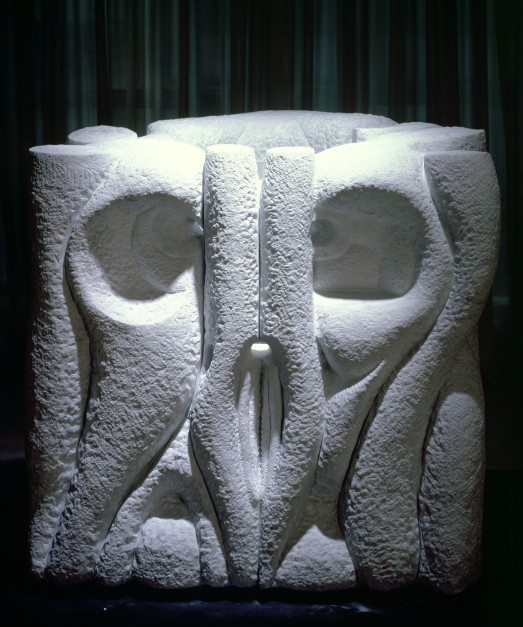 Louise Bourgeois. PASS, 1988-1989. Marble. 50 1/2 x 48 x 37″; 128.2 x 121.9 x 93.9 cm.. Photo: Peter Bellamy, © The Easton Foundation / Licensed by VAGA, NY.
Louise Bourgeois. PASS, 1988-1989. Marble. 50 1/2 x 48 x 37″; 128.2 x 121.9 x 93.9 cm.. Photo: Peter Bellamy, © The Easton Foundation / Licensed by VAGA, NY.
Louise Bourgeois and The Easton Foundation
Louise Bourgeois is one of the most significant and celebrated artists of the 20th and early 21st centuries.
Perhaps best known for her sculptural work in addition to drawing and printmaking, throughout her long career Bourgeois mined the subconscious, as well as memory, trauma, and sexuality, creating imagery that could be seductive, provocative, unnerving, and frequently humorous.
Bourgeois was born in Paris in 1911 and studied at the École du Louvre, Académie des Beaux-Arts, Académie Julian, and the Atelier Fernand Léger. She moved to New York City in 1938, where she lived and worked until her death in 2010. On most art historians’ list of the most important artists of the 20th century, critics have written effusively of her achievements, including Kim Levin’s declaration that “Bourgeois was unrivaled in her ability to render psychological states physical.”1
Bourgeois’ body of work holds particular significance in the arc of modern art history. Art historian Griselda Pollock has described her as a “daringly creative figure” who “straddled the century of Modernism, being formed as an artist when the surrealists were first making their mark in the 1920s and ‘30s and dying in the first decade of the 21st century, when the deeper significance of Surrealism has been so productively reassessed with our interest in sexuality, the body, the uncanny, the fantasmatic.”2 Deeply informed by Abstract Expressionism and Minimalism, her body of work is ultimately distinct within art history, and cannot be completely captured by any particular movement. This may partially explain why Bourgeois did not receive recognition from the art world until relatively late in her career. She was already in her 70s when, in 1982, she was the first woman to have a retrospective at the Museum of Modern Art in New York.
Bourgeois’ work often draws upon details of her early childhood memories and family history. Her depictions of the body were radical not only in their subject matter and directness, but also in their innovative use of materials. During the 1940s, for example, she created precarious vertical sculptures from scrap wood, which she called “Personages.” These works are an early example of her interest in relating the human form to architecture. This theme repeats frequently in her femme-maison works, which probe the relationship of the female body to the physical form of the home. The 1950s saw the addition of plaster, resin, plastic, bronze, and latex to her repertoire. These various materials, some traditional and others novel, allowed her to achieve a remarkable union of flowing bodily forms and rigid architectural structures.
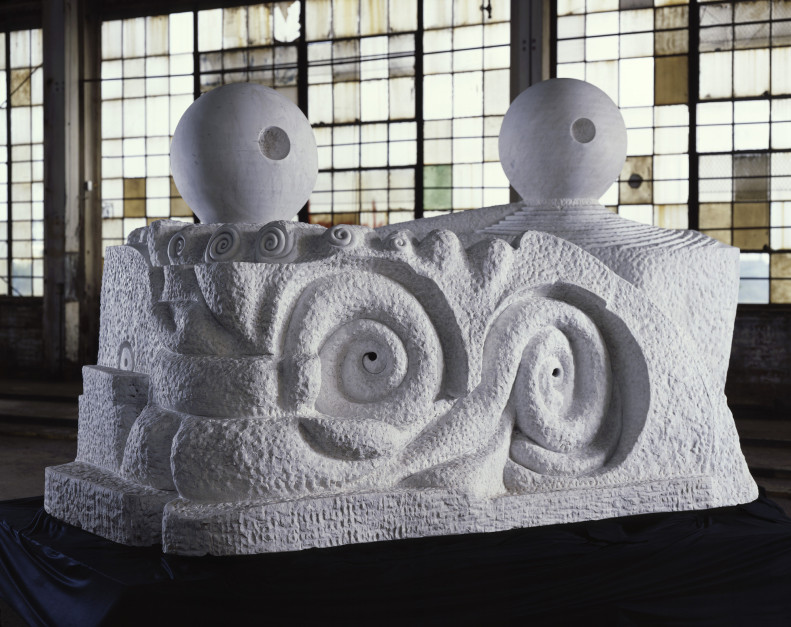 Louise Bourgeois. UNTITLED, 1991. White marble, two units. 1st: 73 x 74 x 115″; 185 x 188 x 292 cm. 2nd: 80 3/4 x 43 1/2 x 100″; 205 x 110 x 254 cm. Photo: Christopher Burke, © The Easton Foundation / Licensed by VAGA, NY.
Louise Bourgeois. UNTITLED, 1991. White marble, two units. 1st: 73 x 74 x 115″; 185 x 188 x 292 cm. 2nd: 80 3/4 x 43 1/2 x 100″; 205 x 110 x 254 cm. Photo: Christopher Burke, © The Easton Foundation / Licensed by VAGA, NY.
Working in collaboration with The Easton Foundation, MASS MoCA will present a tightly focused group of the artist’s work in stone, primarily marble. Bourgeois began using the material in the 1960s while working in Avenza, Italy. She continued to make use of marble throughout the 1980s in the form of large, sometimes monumentally scaled sculptures. Marble offered a new avenue through which to continue exploring motifs she had previously approached through drawing and other sculptural materials, including conflations of bodily and architectural structures, ambiguous sexual forms, and images of organic growth. One particularly extraordinary such work is a massive 15-ton sculpture created in 1991 that will be installed at MASS MoCA as part of its Phase III expansion. A composite of two monolithic units, each measuring over six feet wide and eight feet tall, the work combines tightly coiled spirals and polished globes with rough cut stone surfaces, confronting viewers with its imposing mass and density. Bourgeois sees a parallel between the sense of confrontation often evoked by her works in marble and her own experience working with the challenging material: “How are you going to…make the stone say what you want when it is there to say “no” to everything. It forbids you. You want a hole, it refused to make a hole. It is a constant source of refusal. You have to win the shape. It is a fight to the finish at every moment…the thing that had to be said was so difficult and so painful that you have to hack it out of yourself and so you hack it out of the material, a very, very hard material.”3
Towards the end of her career Bourgeois used smaller marble pieces as components of larger works. Her use of white marble, in particular, makes reference to notions of virginal purity and re-birth. The hard material is also noted for its unusual ability to suggest the suppleness of human flesh, making it an apt medium for Bourgeois’ depictions of bodily fragments and biomorphic structures.
The installation of Bourgeois’ sculpture at MASS MoCA will be a complement to her existing presence in the region. Since 2001, the Williams College Museum of Art has been the home of a permanent outdoor sculpture by the artist designed specifically for the museum’s grounds. The WCMA installation, titled Eyes (nine elements), consists of a series of bronze and granite eyes that range in height from three to seven feet. The work, which glows with electric blue light at night, draws from the artist’s familiar iconographic vocabulary. Bourgeois often incorporated imagery of eyes to allude both to perception and to female sexual anatomy. Placed amid berms at the front of the museum, the eyes draw attention to the museum while lending the surrounding landscape peculiar sentience.

James Turrell, Breathing Light, 2013. LED Light into space. Dimensions variable. Los Angeles County Museum of Art. Photo / Floriann Holzerr
James Turrell
James Turrell uses light as a sculptural material and a tool for perceptual explorations.
Born in Pasadena, California, in 1943, he studied psychology and mathematics at Pomona College before pursuing graduate studies in art at the University of California, Irvine and Claremont Graduate University. A pioneer in the Southern California Light and Space movement of the 1960s and ‘70s, Turrell began using light as a sculptural medium in 1966, controlling the passage of light through the windows of his Santa Monica studio to create uncanny illusions of weight and volume. Between 1968 and 1969, Turrell participated in the Los Angeles County Museum of Art’s ‘Art and Technology’ program and collaborated with artist Robert Irwin and psychologist Dr. Edward Wortz of the Garrett Aerospace Corporation on experiments with a Ganzfeld chamber, a space which eliminated all aural and visual stimulation. Turrell’s work later evolved into more carefully calibrated light projections and environments which produced profound visual and sensory effects for viewers — illusions of three-dimensional floating forms, unmodulated fields of color, and an utter lack of architectural edges or any other form of spatial orientation.
Turrell’s Skyspaces, installed in various sites across the world, frame a portion of the sky through a large opening cut into the ceiling of the host structure. These installations highlight natural shifts in light, sometimes intensified by additional projected light within the viewing chambers. This subtle alteration of visual observation encourages a view of the sky as a moving canvas.
In 1979, the artist acquired Roden Crater, an extinct volcano in the Arizona desert, with the aim of transforming it into a massive celestial observatory. Still in progress, this monumental undertaking will frame astrological phenomena for the naked eye by manipulating interactions of light and space within and beyond the crater.
Turrell’s work has been shown extensively in museums across the world, including solo exhibitions at the Museum of Modern Art, New York; the Whitney Museum of American Art, New York; the National Gallery of Art, Washington, D.C.; Centre George Pompidou, Paris; and the National Gallery of Australia, Canberra. In 2013, three concurrent retrospectives of his work were held at the Solomon R. Guggenheim Museum, New York, the Museum of Fine Arts, Houston, and the Los Angeles County Museum of Art. His work is included in numerous public collections, and his Skyspaces can be found on museum grounds, college campuses, and other public and private sites throughout the world. In 1984, Turrell received a ‘genius’ award from the Katherine T. and John D. MacArthur Foundation Fellowship, and in 2013 he was awarded a National Medal of Arts from the National Endowment for the Arts.
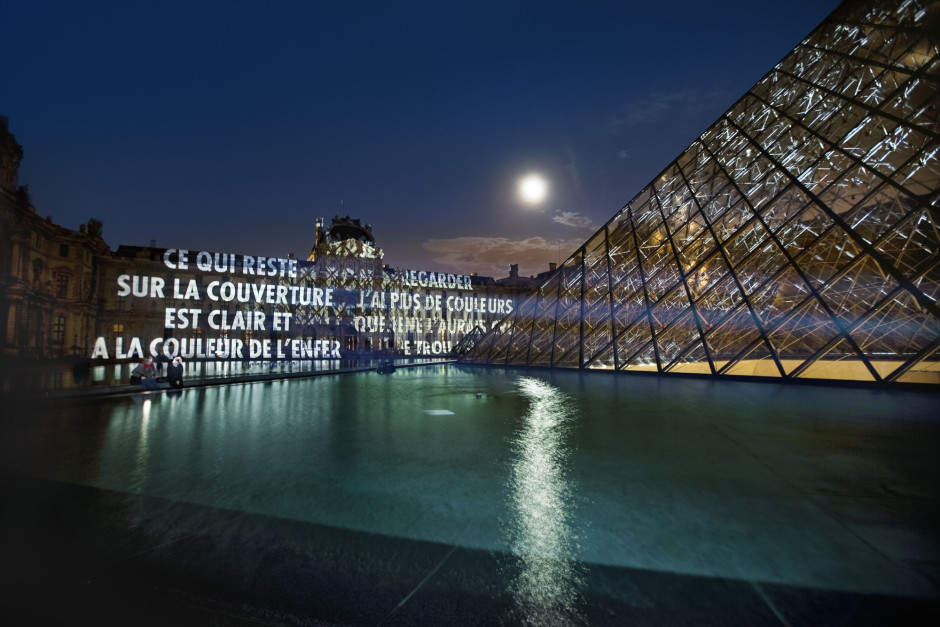 Xenon for Paris, 2009. Light projection. Louvre Pyramid, Napoleon Courtyard, Paris. Text: Lustmord, 1993–95; Truisms, 1977–79; Laments, 1989. Collection, National Contemporary Art Fund, Paris. © 2009 Jenny Holzer, member Artists Rights Society (ARS), NY. Photo: Lili Holzer-Glier.
Xenon for Paris, 2009. Light projection. Louvre Pyramid, Napoleon Courtyard, Paris. Text: Lustmord, 1993–95; Truisms, 1977–79; Laments, 1989. Collection, National Contemporary Art Fund, Paris. © 2009 Jenny Holzer, member Artists Rights Society (ARS), NY. Photo: Lili Holzer-Glier.
Jenny Holzer
For more than thirty years, Jenny Holzer has presented her astringent ideas, arguments, and sorrows in public places and international exhibitions, including the Venice Biennale, the Guggenheim Museums in New York and Bilbao, and the Whitney Museum of American Art. Her medium — whether formulated as a T-shirt, a plaque, or as an LED sign — is writing, and the public dimension is integral to the delivery of her work.
Starting in the 1970s with the New York City posters, and up to her recent light projections on landscape
and architecture, her practice has rivaled ignorance and violence with humor, kindness, and courage. While her subversive work often blends in among advertisements in public spaces, its arresting content violates expectations. Holzer’s texts — such as the aphorisms “Abuse of power comes as no surprise” and “Protect me from what I want” — have appeared on posters and condoms, and as electronic LED signs and projections of xenon light. Holzer’s recent use of text ranges from silk-screened paintings of declassified government memoranda detailing prisoner abuse to poetry and prose in a sixty-five-foot wide wall of light in the lobby of 7 World Trade Center, New York.

Jenny Holzer from Survival (1983–85), 1985. Electronic sign. 20 x 40 ft. / 6.1 x 12.2 m. Installation: Selection from the Survival Series, Times Square, New York, 1985. © 1985 Jenny Holzer, member Artists Rights Society (ARS), NY. Photo: John Marchael.
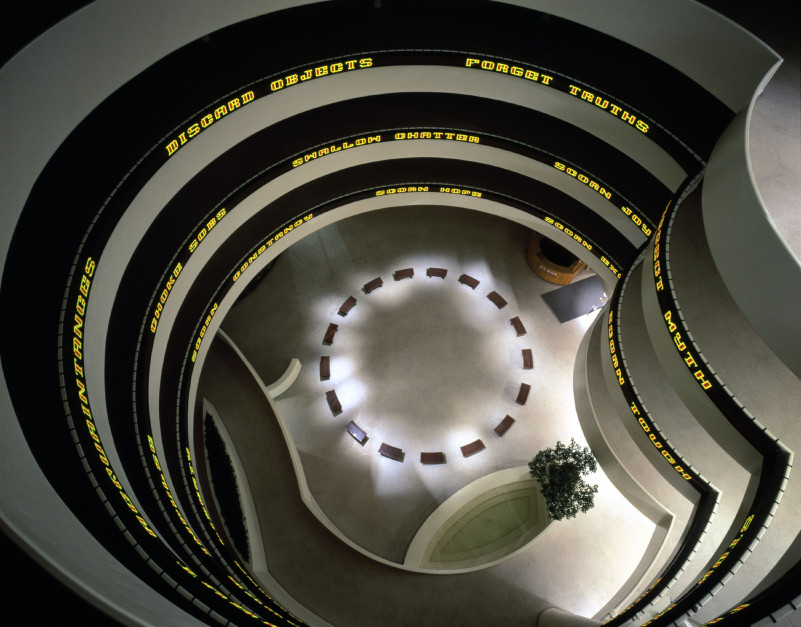
Exhibition view: Jenny Holzer, Solomon R. Guggenheim Museum, New York, 1989. © 1989 Jenny Holzer, member Artists Rights Society (ARS), NY. Photo: David Heald.
Holzer received the Leone d’Oro at the Venice Biennale in 1990 and the Crystal Award from the World Economic Forum in 1996. She holds honorary degrees from Ohio University, Williams College, the Rhode Island School of Design, The New School, and Smith College. She received the Barnard Medal of Distinction in 2011. Holzer lives and works in New York.
Though the artist frequently utilized exterior light projections in public spaces, her first interior projections were shown in 2006 at the MAK in Vienna, where she collaborated with the Austrian writer and Nobel laureate, Elfriede Jelinek. The interior projections create an immersive environment where legible texts overlap and ride into a surround of white light and language. With two projectors facing each other, the seemingly empty room is transformed into a flooded meeting place of bodies, words, and visual subtleties. Whether in urban or rural settings, outdoors or inside, using her own writings or those of others, the ambition of each projection remains the same: “I show what I can with words in light and motion in a chosen place, and when I envelop the time needed, the space around, the noise, smells, the people looking at one another and everything before them, I have given what I know.” In PROJECTIONS, which was on view at MASS in 2007 and 2008, Holzer used MASS MoCA’s massive Building 5 as the site of her first interior light projections installed in the United States. In an adjoining gallery, Holzer exhibited a new series of paintings based on redacted, declassified government documents.
Holzer has received many awards, including the Golden Lion from the Venice Biennale (1990); the Skowhegan Medal (1994); and the Diploma of Chevalier (2000) from the French government. Major exhibitions include Neue Nationalgalerie, Berlin (2001); Contemporary Arts Museum, Houston (1997); Dia Art Foundation, New York (1989); and Solomon R. Guggenheim Museum, New York (1989). Since 1996, Holzer has organized public light projections in cities worldwide. She was the first woman to represent the United States in the Venice Biennale (1990). Jenny Holzer lives and works in Hoosick Falls, New York.
Jenny Holzer was born in Gallipolis, Ohio, in 1950. She received a BA from Ohio University in Athens (1972); an MFA from the Rhode Island School of Design, Providence (1977); and honorary doctorates from the University of Ohio (1993), the Rhode Island School of Design (2003), and New School University, New York (2005).
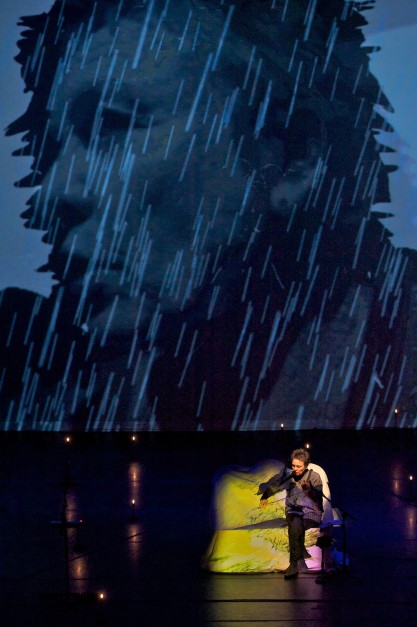
Laurie Anderson performing Delusion. Credit Leland Brewster.
Laurie Anderson
|
Laurie Anderson is one of today’s premier multimedia artists, working as music composer, filmmaker, inventor of unique musical instruments, painter, poet, photographer, vocalist, multi-instrumentalist, and storyteller. She has earned widespread critical acclaim for her lyrical and often deeply personal interpretations of science and current events, while her success in spanning the worlds of avant garde art and popular culture is almost unique in the world today. In 1980, the song O Superman launched Anderson’s recording career, rising to number two on British pop charts, and winning widespread radio play in the United States. The song subsequently appeared on her |
|
landmark concept album Big Science. Other milestone albums include Mister Heartbreak, United States Live, Strange Angels, Bright Red, and the soundtrack to her feature film Home of the Brave. A deluxe box set of her productions under the Warner Brothers label, Talk Normal, was released in the fall of 2000. In 2001, she released Life on a String, which was followed by Live in New York, recorded at City Hall in New York City in September 2001, and Homeland (2010). Anderson has toured internationally with theatrical productions that range from intimate spoken word performances of her poetic narrative texts, to elaborately staged multimedia sound and light spectacles. Major theatrical works include United States I-V (1983), Empty Places (1990), The Nerve Bible (1995), and Songs and Stories for Moby Dick. In the fall of 2001, Anderson toured the United States and Europe with a three-person band, performing music from Life on a String. She has presented solo works, including Happiness (2001) and Delusion (2010), which premiered at the 2010 Vancouver Olympic Games. In 2003, The Musée d’art contemporain de Lyon in France produced a touring retrospective of Anderson’s work, The Record of the Time: Sound in the Work of Laurie Anderson. The exhibition encompassed installation, audio, video, and art objects and spanned Anderson’s career from the 1970s to her most current works. As a composer, Anderson has contributed music to films by Wim Wenders and Jonathan Demme; music for dance pieces by Bill T. Jones, Trisha Brown, and Molissa Fenley, and a score for Robert LePage’s theater production, Far Side of the Moon.
Laurie Anderson performing Delusion. Credit Leland Brewster. |
|
Recognized as a groundbreaking leader in the use of technology in the arts, Anderson collaborated with Interval Research Corporation — an R&D laboratory for the arts and sciences founded by Paul Allen and David Liddle — focusing on the exploration of new creative tools, including the Talking Stick. In 2002, Anderson was appointed the first artist-in-residence of NASA. Other awards include the 2001 Tenco Prize for Songwriting in San Remo, Italy, and the 2001 Deutsche Schallplatten prize for Life On A String, the 2010 Woman of Achievement Award from Women’s Project Theater, the 2012 Inaugural Distinguished Artist-in-Residence at EMPAC in Troy, NY. In 2014 she was inducted into the MASS MoCA Clocktower Society, and in 2015 will be an artist-in-residence at the Rauschenberg Foundation in Captiva, FL. |
Anderson lives in New York City. For more information, please visit www.laurieanderson.com.
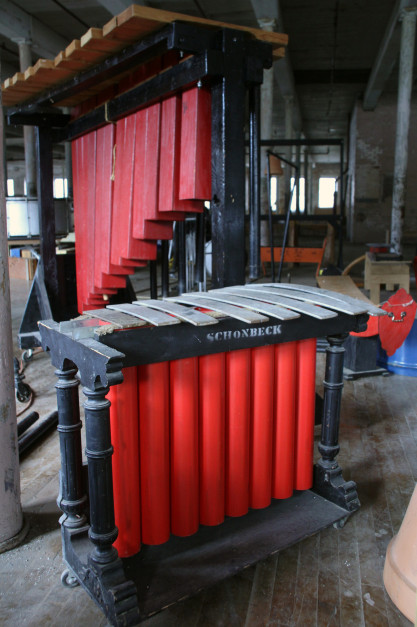
Gunnar Schonbeck Instruments at MASS MoCA.
Gunnar Schonbeck and Bang on a Can
Over a period of fifty years, Gunnar Schonbeck (1917-2005) built an arsenal of unlikely handmade musical instruments: a 9-foot banjo, drums made from aircraft nose cones, an 8-ft tall marimba, welded steelharps, and countless steel drums, zithers, pan pipes, tubular chimes, and triangular cellos, many labeled with his signature stencil design saying simply “Schonbeck”. This bizarre Schonbeckian instrumentarium gradually accumulated in his garage and an attic at Bennington College, where Schonbeck taught, composed, and made music for over half a century. MASS MoCA relocated most of the surviving instruments to North Adams for its 2011 Solid Sound Festival, where they were utilized for performances and demonstations by members of Wilco and other musicians. The instruments have become a festive part many musical events since, most notably the annual Bang on a Can Festival of new music that takes place at MASS MoCA every July.
As part of the Phase III renovations, and with the help of members of the Bang on a Can consortium — and especially Mark Stewart, who has been restoring and working with the instruments over the past 3 years — MASS MoCA will place the instruments in open music rehearsal galleries, where professional visiting musicians, museum visitors, and schoolchildren will be invited to play.
Schonbeck’s philosophy was that “everything and everybody has a unique sound; you just have to bring it out.” Schonbeck spent his life as an excavator of music, not only through his musical inventions, but also through wildly inventive and interactive community concerts, in which the composer invited students, friends, and neighbors to participate in ad hoc ensemble concerts, playing his instrument inventions, dancing, and singing in parks and fields around Bennington. At the peak of his career, Schonbeck had assembled more than 1,000 handmade instruments in his collection, which would be played by as many as 300 volunteer musicians at a time during multimedia extravaganzas — part concerts, part parade, part block parties — that were as memorable to their participants as they were cacophonous. During his career he composed countless “collages”, as he called them, which ranged from marching band songs to Japanese-influenced “sound paintings”. His compositions were played by both massive community gatherings, and by professional colleagues who admired his ardently held belief in universal human musicality.
Gunnar Schonbeck was born in Springfield, Massachusetts, the son of Swedish immigrants. He became a clarinetist, playing in the WPA orchestras, the Boston Symphony, and the Military Band at West Point. At the end of WW II, he traveled to Bennington, and started building his unique instrumentarium. In 1945, he was asked to visit Bennington College, and in 1946 he accepted a teaching position at the College where he stayed for over half a century, until 1999. Schonbeck also taught at The Putney School, Wellesley College, the Longy School of Music, MIT, Harvard, and Middlebury College.
—————————–

Hall Art Foundation at MASS MoCA. Building designed by Bill Katz and Alex Haviland.. Photo: Arthur Evans. Courtesy Hall Art Foundation. © Hall Art Foundation.
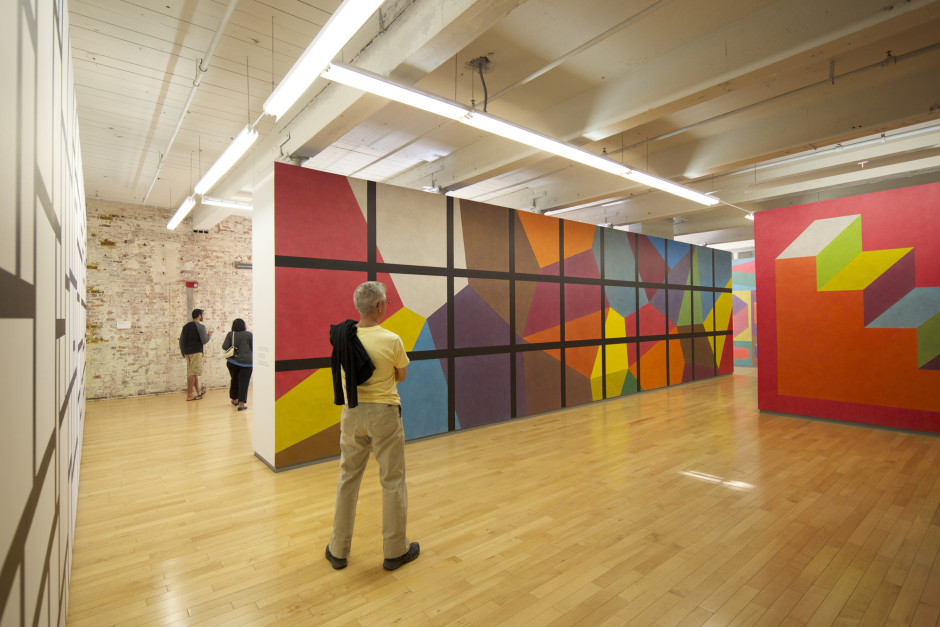
Sol LeWitt, Wall Drawing 692: Continuous forms with color in washes superimposed. (1991). Credit Zoran Orlić.

Zoran Orlic, Campus Image, 2013
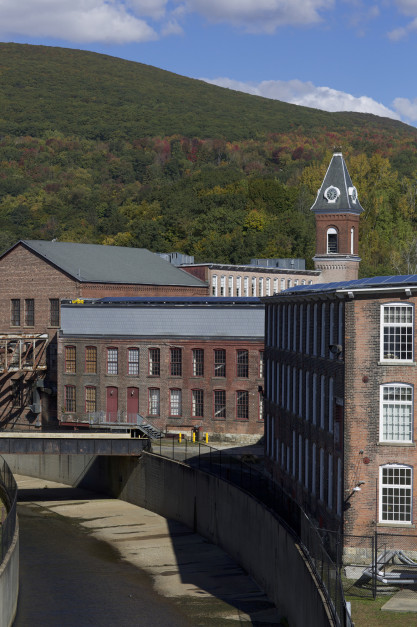
Iconic clocktower, MASS MoCA buildings, Berkshire mountains, Hoosic River. Zoran Orlic, Campus Image, 2013.

Massachusetts Museum of Contemporary Art
North Adams, Berkshires
www.massmoca.org
Copy & Images courtesy of MASS MoCA.
———————————————————–Footnotes:
1 — Kim Levin, “Where Ecstasy Met Malice: Louise Bourgeois: Innovator, Role Model, Contrarian,” ARTnews 109, 7 (Summer 2010): 58.2 — Griselda Pollock, “Louise Bourgeois 1911-2010,” Art Monthly 338 (July-Aug 2010): 22. 3 — M. L. Bernadac and H. U. Olbrist (eds.), Louise Bourgeois: Destruction of the Father, Reconstruction of the Father, Writings and Interviews 1923-1997 (Violette Editions: London, 1998), 184. Quoted in Alex Potts, “Louise Bourgeois: Sculptural Confrontations,” Oxford Art Journal 22, 2 Louise Bourgeois (1999): 44.
________________________________________________________
~~~~~~~~~~~~~~~~~~~~~~~~~~~~
Visit these AAQ Museum Architecture Portfolios (links)
Glenstone, Potomac, Maryland / 2006 – 2008
Harvard Art Museums, Cambridge / 2014
MAD — Museum of Arts and Design, NYC / 2016
Parrish Art Museum, Water Mill, NY / 2012
The Clark Institute of Art, Berkshires / 2014
The Morgan Library & Museum, NYC / 2006
Wadsworth Atheneum Museum of Art, Hartford / 2017
Whitney Museum of American Art, NYC / 2015
Yale University Art Gallery, New Haven / 2012
_______________________________________________


